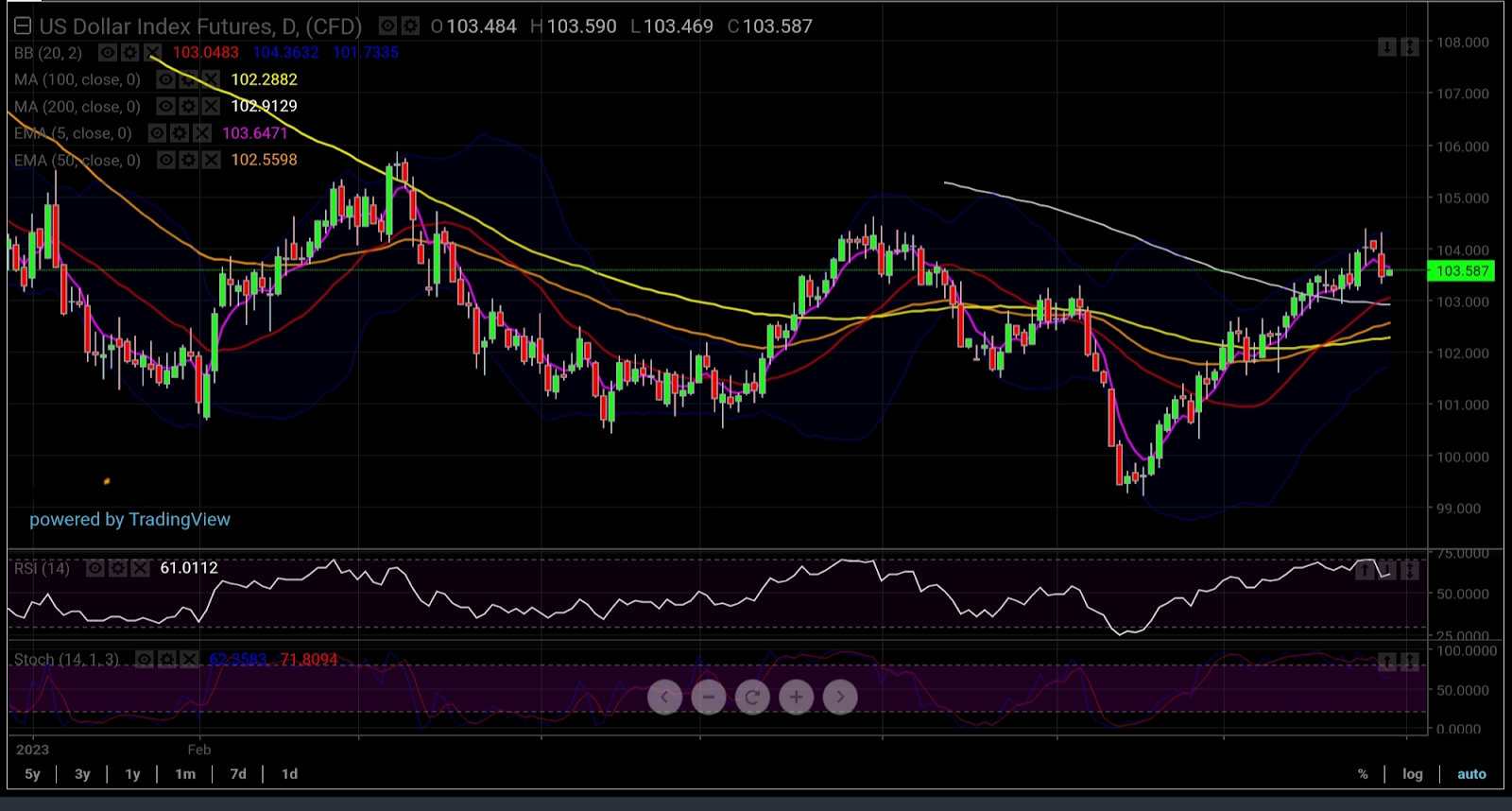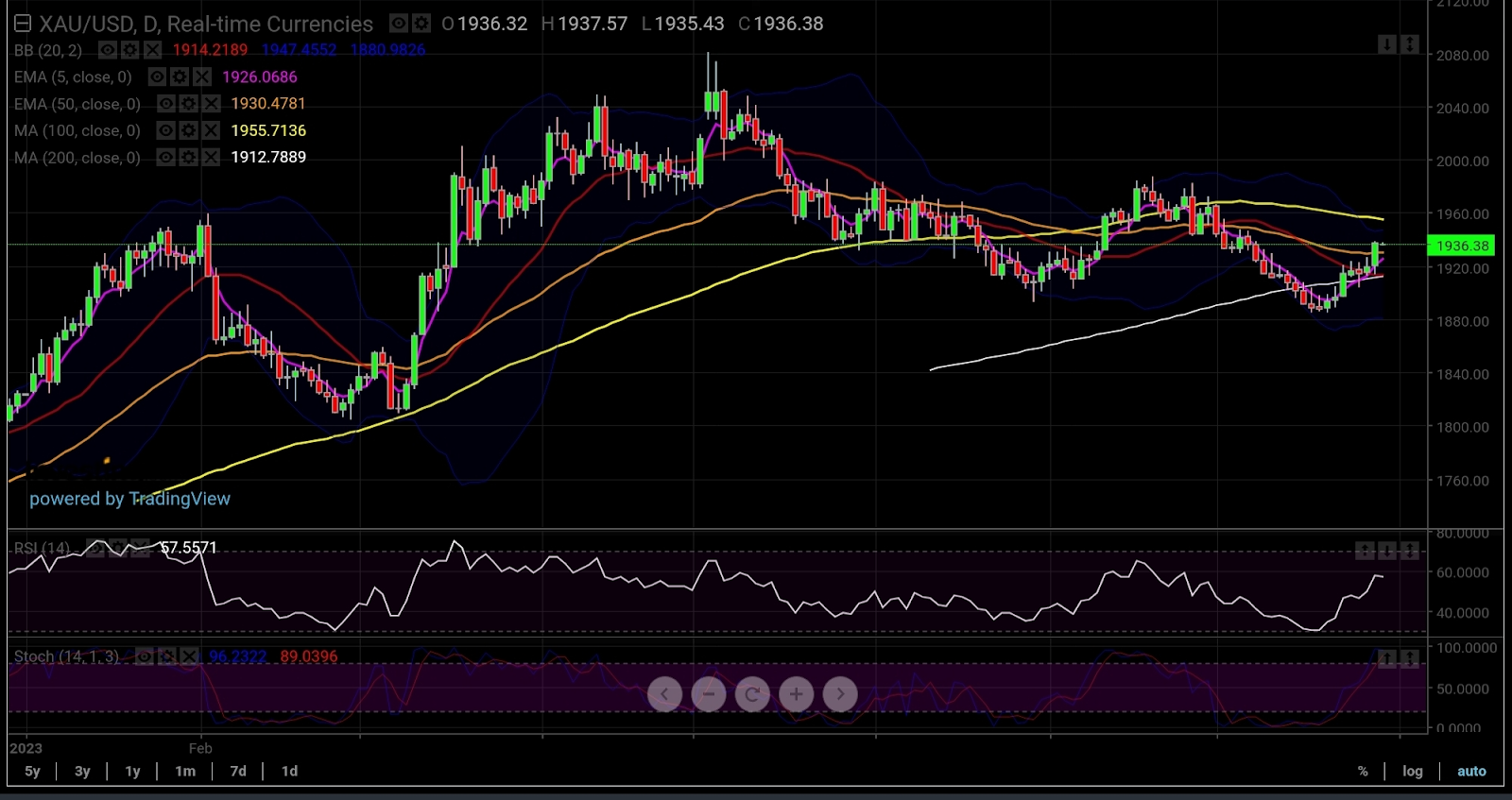- Gold bugs anticipate the August non-farm payrolls to be the weakest in 2-½ years
- Historical trends show mixed reactions in gold prices to lackluster U.S. job data
- If the numbers do meet expectations, the Fed is likely to interpret slowing job growth as a sign of reduced inflationary pressure
- Dollar Index stability above 5-Day Exponential Moving Average, or EMA, of 103.65 encourages further recovery to 103.91, above which the targets would be 104.15, 104.35 and 104.60 respectively.
- If $1,940 forms into an active resistance for spot gold, expect some correction towards 50-Day EMA of $1,930, followed by the 5-Day EMA of $1,925 and the horizontal support levels $1920 and $1915
- Dollar Index stability below the 5-Day EMA of 103.65 signifies weakness that could push it lower, towards the Daily Middle Bollinger Band of 103.05 and the 200 Day SMA of 102.90.
- A break below 102.90 on DX will push the index further down toward 50-Day EMA of 102.56 and the 100-Day SMA of 102.30
- Gold will likely derive support from a weakening dollar, increasing the odds of its possibility of gradually approaching the Weekly middle Bollinger Band $1951 followed by 100 Day SMA $1955
As far as gold bugs are concerned, the writing is on the wall: The August non-farm payrolls are going to be the weakest in 2-½ years — enough to cool Fed hawks, crush the dollar and set their favorite metal on another trajectory towards $2,000 an ounce.
The problem is history hasn’t been on the side of gold longs — not at least after recent US jobs numbers. And Friday’s expected addition of 170,000 payrolls — the smallest in 30 months, if correct — might not be an exception.
Case in point: After the July payroll numbers, announced on Aug 4, showed a growth of 187,000 versus a forecast 200,000, the spot price of gold, known as XAU in trading circles, fell almost non-stop for two weeks — going from just under $1,942 to below $1,8887 by Aug 18.
Gold did a little better after the release of the June payrolls on July 7. On that occasion, too, jobs growth was the smallest in 2-½ years, at 185,000 versus a forecast of 225,000. Spot gold went from under $1,925 to $1,964 — a near $40 premium.
In fact, for this year, gold hasn’t had a $2K moment outside of March to May. Those were the months when jobs growth first began to slow, then started trending higher before sliding again.
Sunil Kumar Dixit, chief technical strategist at SKCharting.com and a regular provider of commodity technicals to Investing.com says the inherent strength in recent weeks of the Dollar Index, which goes by the DX trading symbol, would limit any downside for the US currency.
“Conversely, the RSI upside is limited for gold,” Dixit said, referring to the yellow metal’s Relative Strength Index.
Gold traders would be cautiously monitoring reaction toward the $1,955 resistance zone before building any optimism further out towards $1,985-$2,000, he added.
“At the most, we could see a bullish range of between $1,945 and $1,955 before sellers step in again and try to take it back to the previous swing low of $1,920 to $1,885.”
US Payrolls, Inflation, and the Fed
Wall Street economists have predicted a non-farm payrolls growth of just 170,000 for August. If that turns out to be accurate, it would be the smallest monthly growth in US jobs since February 2021, overwriting a similar milestone set in July when the 187,000 new payrolls then proved the lowest in 2-½ years.
Job openings data for July, released separately by the Labor Department on Tuesday, suggested the payrolls forecast might be on track.
US job openings fell to a near 2-½ year low in July, signaling a cooling in employment likely to be welcomed by the Federal Reserve in its bid to see less inflationary pressure. Specifically, there were 8.8 million jobs open at the end of July, a drop from the 9.16 million in June, the Labor Department’s Job Opening and Labor Turnover Survey said.
The so-called JOLTS report came ahead of Friday’s more important non-farm payrolls for August, which will be crucial for the Fed’s next interest rate decision on Sept 20.
Economist Greg Michalowski wrote on the ForexLive platform:
“Not only was the job openings the lowest since March 2021, the number of hires decreased, and the quits rate decreased as well.”
“If workers are less willing to quit their jobs, it means they are less confident about getting another job sooner rather than later.”
Inflation, measured by the Consumer Price Index, or CPI, hit four-decade highs of more than 9% per annum in June 2022 due to trillions of dollars of federal relief spending following the 2020 coronavirus outbreak. The Fed responded with its most aggressive rate hikes in 20 years, going from a base rate of just 0.25% in March 2022 to 5.5%.
While pandemic-related spending is in the rear-view mirror and the CPI has stabilized at 3% per annum now, a robust labor market has allowed Americans to continue spending, preventing the Fed from achieving its target for inflation.
On Thursday, the Fed will get to see if the or Personal Consumption Expenditures, or PCE, Index — which serves as the central bank’s favorite inflation indicator, shows an even more benign number than the CPI,
Weekly jobless claims have continued to decline in the United States, with unemployment hitting more than 50-year lows, while average hourly earnings haven’t contracted in a single month since April 2021.
Fed Chairman Jerome Powell said last week the labor market's rebalancing was "incomplete." Powell has repeatedly noted that getting inflation back down to the central bank’s 2% goal will require "some softening in labor market conditions."
The Fed chief made clear that US rates will follow inflationary pressure.
“We are prepared to raise rates further if appropriate, and intend to hold policy at a restrictive level until we are confident that inflation is moving sustainably down toward our objective,” Powell said.
Most money market traders think the Fed will leave the key US lending rate unchanged at 5.5% at its September 20 meeting. But some 43% in a poll said the central bank will likely opt for a 0.25 percentage point increase at its November policy meeting.
Dollar & Gold: Post-Payrolls Outlook

Charts, technical analysis by Sunik Kumar Dixit of SKCharting.com
Stronger DX / Weaker XAU

Charts, technical analysis by Sunik Kumar Dixit of SKCharting.com
Weaker DX / Stronger XAU
***
Disclaimer: The aim of this article is purely to inform and does not in any way represent an inducement or recommendation to buy or sell any commodity or its related securities. The author Barani Krishnan does not hold a position in the commodities and securities he writes about. He typically uses a range of views outside his own to bring diversity to his analysis of any market. For neutrality, he sometimes presents contrarian views and market variables.
